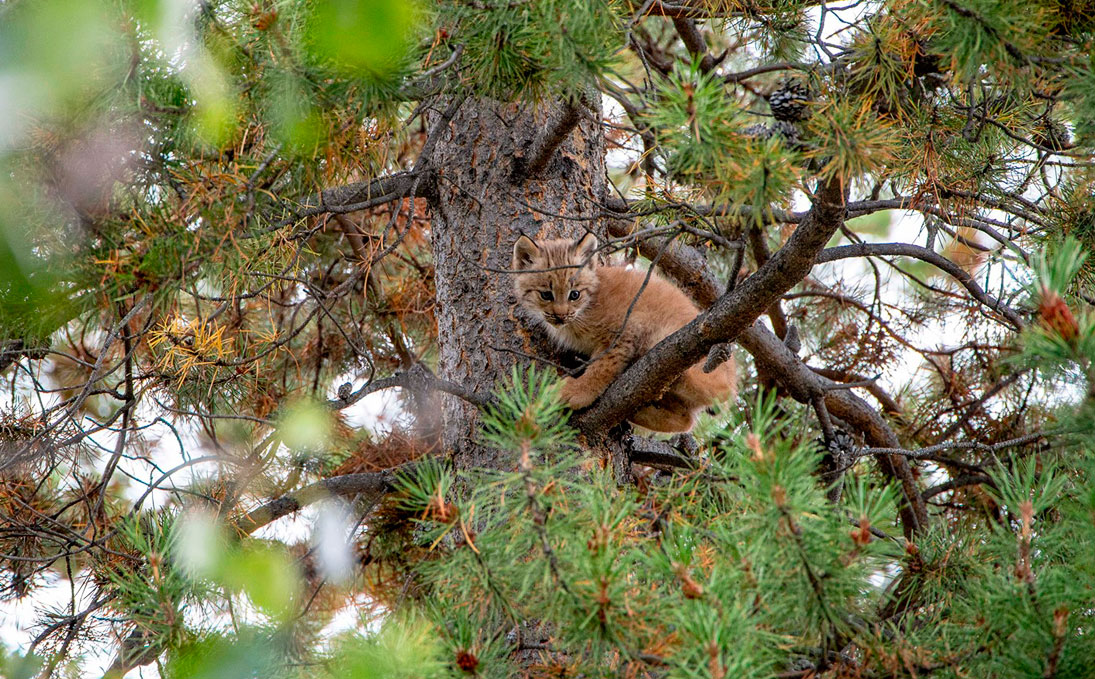
Photo by Photo Submitted
BRANCHING OUT – A lynx kitten is seen in a tree at the preserve. Photo courtesy YUKON WILDLIFE PRESERVE

Photo by Photo Submitted
BRANCHING OUT – A lynx kitten is seen in a tree at the preserve. Photo courtesy YUKON WILDLIFE PRESERVE
Visitors to the Yukon Wildlife Preserve have a couple more reasons to enjoy their visits these days.
Visitors to the Yukon Wildlife Preserve have a couple more reasons to enjoy their visits these days.
The long-anticipated lynx kittens have finally made their debut, to the delight of both staff and visitors.
According to Jake Paleczny, the preserve’s executive director, three kittens were born to the older female in the lynx enclosure on June 20.
That’s somewhat later in the season than expected, he said in an interview Tuesday, but animals often “do their own thing.”
“A few years ago we had a bison calf born in the fall,” Paleczny noted as an example. “That one was just on its own schedule.”
With a gestation period of about two months, the birthdate would suggest the female lynx was successfully bred in late April. That’s as much as a month later than would typically be the case.
Like house cats, lynx kittens are born blind and relatively helpless.
That makes it easier for the mother to look after them for as long as a month or so, and to keep them confined.
Once their eyes open and they become more co-ordinated and capable of movement, Paleczny said that task becomes next to impossible.
He said in many ways, captive lynx behaviour and traits are much like a domestic cat.
“There are some important differences though,” he said dryly.
The kittens have been out for a few weeks, exploring the enclosure and practising their climbing skills.
That’s delighted the people who have seen them, often perched in trees.
Unfortunately, one of the kittens suffered an injury after getting stuck between two willow trees about two weeks ago.
It was unable to escape without human assistance, and is receiving treatment for what is likely a nerve injury.
It was discovered by staff and visits during a bus tour. The agitated mother was circling and calling out.
Staff freed it, but the kitten had been trapped in an awkward position for an undetermined time and had put a great deal of pressure on one of the main nerves in a back leg, Paleczny said.
It currently has normal movement in its hip, but quite a bit less use of the remainder of its leg.
Veterinarian staff have told him nerve injuries are slow to heal, and it could be months before the kitten will have good use of its leg.
It’s an unpredictable injury, he said.
Until then, the kitten will remain housed in the rehab unit where it can be safely monitored.
The lynx enclosure at the preserve is suitable for three or four cats, Paleczny said. There are currently three adults living there, an older male and female born in 2008, and a younger female.
The two older cats are the parents of the current litter.
The older female is the mother of that younger cat, which has not produced a litter as yet.
This was the preserve’s first attempt at breeding her.
Frequent visitors to the preserve will recognize the male, which is missing a foot.
With the advancing age of the older cats, Paleczny said, the preserve is planning for a succession of sorts to maintain a lynx population at the preserve.
Some or all of the kittens could be moved to another accredited facility to help accommodate that and to improve bloodlines for captive breeding programs, he said.
The preserve is in the preliminary stages of investigating that, and it’s unclear where they might be moved to.
That decision is likely at least a few months off, as the third kitten recovers and talks continue between the preserve staff and other facilities.
The lynx kittens and some calves amongst the bison herd are the only youngsters for the facility this year.
Paleczny said there had been hopes that some of the resident caribou would give birth this year, but that didn’t materialize.
The number of visitors is up significantly in recent weeks, which he said is good news for the facility, located off the Takhini Hot Springs Road.
Yukoners have been great at supporting the preserve during COVID, he said, but numbers have picked up since the health regulations were relaxed by the government on Aug. 4.
In order to encourage thoughtful and responsible discussion, website comments will not be visible until a moderator approves them. Please add comments judiciously and refrain from maligning any individual or institution. Read about our user comment and privacy policies.
Your name and email address are required before your comment is posted. Otherwise, your comment will not be posted.
Be the first to comment